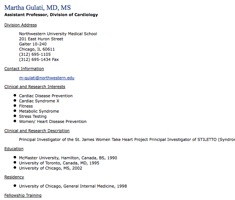
|

Dr. Martha Gulati on Healthy Living
Martha Gulati, M.D., M.S., FACC, is an assistant professor of medicine and preventive medicine at Northwestern University’s Feinberg School of Medicine, as well as the associate medical director of The Bluhm Cardiovascular Institute of Northwestern Memorial Hospital’s Center for Women’s Cardiovascular Health. She received her medical degree from the University of Toronto and completed her residency in internal medicine and her cardiology fellowship at the University of Chicago, where she also received her MS in health studies for clinical professionals. Currently, she’s the primary investigator of the Women Take Heart Project and is involved in research with the Women Ischemic Syndrome Evaluation and the Women’s Health Initiative. In addition to her extensive clinical publication credits, Gulati is the co-author of Heart Power Recipes, a heart-healthy cookbook. Some of Dr. Gulati’s most recent research focuses on women’s exercise capacity as it relates to their age and level of fitness, which she defines as a measure of how much oxygen is consumed during a given activity. In this interview, Gulati explains how men and women can use this information to improve their health.
Based on your recent studies and research, what do women really need to know about exercise? What’s something they may not have heard of before?
We’ve been studying about 6,000 women from the Chicago area since 1992. What we’ve found is that there’s a different fitness level for every age group. Whenever you’re talking about improving your lifestyle and health, to me that also means improving your level of fitness.
What I would suggest to women is that they start paying attention to their fitness, because fitness is a measure of how much oxygen you consume for any given activity. This can be measured through something called a metabolic-equivalents, or METS. Although that used to be quite a foreign word, nowadays METS are on almost all cardio equipment, no matter what gym you use. I think what we’re hoping is that women will recognize that number and recognize that it means something, not just the calories you’re burning or how fast your heart rate is going.
Is there a formula one can use to determine her specific METS level?
To determine your age-appropriate METS, women can use the following formula: 100 percent METS = 14.7 – (0.13 x age). For example, if you did this for a 60-year-old woman, she would have to reach about seven METS to achieve 100% of her age-predicted fitness level. So if she saw “7” on the MET area on that treadmill, she should feel pretty proud of herself. If she’s not there, she should try to achieve it. That, of course, requires an exercise prescription with the help of your physician and trainer.
Is there an equivalent equation for men?
Yes, and it’s not very different at first glance: 100% METS = 14.7 – (0.11 x age). Although that 0.11 looks very close to 0.13, if you put the number 60 in there for men and women, you’ll see that there’s a MET difference.
How much change can one expect within the first 30 days?
From my clinical experience, the first 30 days are the hardest—particularly the first two weeks. Making exercise a priority, a pattern and a part of your life is a long-term commitment. If you can keep with it for a month, you can keep with it forever. During the first two weeks, people usually feel tired, sore and exhausted. Some of them feel like they’re gaining weight because they’re putting on muscle. Also, people tend to get discouraged when they’re always jumping on the scale. Instead, get hung up on the right numbers, like METS, that show you’re working out and you’re doing some activity.
What common mistakes do people make about fitness and exercise?
The big mistake we see comes from the New Year’s warriors: They make a commitment in the first 30 days to do everything right. They cut everything out and have an impossible regimen to follow. That never works.
What helps some people stick with a fitness plan?
Unfortunately, many of my patients make the commitment after they’ve had a heart attack; they make it happen because they’ve been scared. They’re the lucky ones; they’re the ones who go home from the hospital. We know that quite a number—more than 50 percent—die before they even get to the hospital or while they’re in the emergency room. As a preventative doctor, I wish we could get to more people before the heart attack and before they have coronary disease, in order to prevent these catastrophic events.
For more information about Dr. Martha Gulati, visit www.medicine.northwestern.edu
About Dr. Martha Gulati
Martha Gulati, M.D., M.S., FACC, is an assistant professor of medicine and preventive medicine at Northwestern University’s Feinberg School of Medicine, as well as the associate medical director of The Bluhm Cardiovascular Institute of Northwestern Memorial Hospital’s Center for Women’s Cardiovascular Health. She received her medical degree from the University of Toronto and completed her residency in internal medicine and her cardiology fellowship at the University of Chicago, where she also received her MS in health studies for clinical professionals. Currently, she’s the primary investigator of the Women Take Heart Project and is involved in research with the Women Ischemic Syndrome Evaluation and the Women’s Health Initiative. In addition to her extensive clinical publication credits, Gulati is the co-author of Heart Power Recipes, a heart-healthy cookbook. Some of Dr. Gulati’s most recent research focuses on women’s exercise capacity as it relates to their age and level of fitness, which she defines as a measure of how much oxygen is consumed during a given activity.





